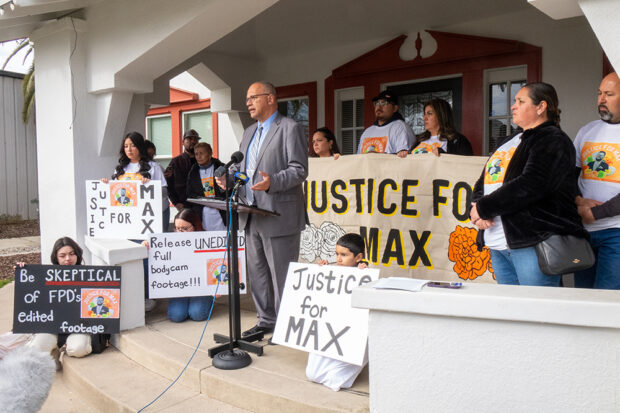
On Nov. 4, Max Sosa Jr., 33, was shot dead by Fresno police. Police responded to an apartment building in northwest Fresno due to a call for help regarding a situation in which Sosa was threatening to commit suicide. The person who made the call was identified as Sosa’s wife, from whom he had separated months before.
The Sosa family’s attorney, Kevin Little, said that Sosa had no police record and was going through a situation of mental stress and that the victim’s behavior was not a danger to the officers.
The family asked the police to hand over the videos from the body cameras of the officers, but the police provided only part of the videos, arguing that the case is under internal investigation.
At a press conference on Jan. 12, attorney Little showed part of the police video in which it can be seen that Sosa was staggering from the effect of having received a Taser shot and that he was heading toward the officers with his arms down, not in an aggressive position. However, the police fatally shot Sosa and argued that Sosa was approaching them with scissors in his hand.
Little and Sosa’s relatives who were present at the press conference say that Sosa was killed unnecessarily and question the police version. For example, first the Fresno Police Department (FPD) talked about the presence of three officers but later it was learned that there were four instead.

“As seen in the video, Sosa was falling forward, powerless from the impact of the Taser, with his head down…how dangerous can someone like that be?” asks Little.
Can’t four police officers control a person injured by a Taser shot? Sosa’s relatives asked. Also, why didn’t the police call a specialist to deal with Sosa, who was the father of two children, ages two and four?
“The police gave us an edited video to justify what they did,” says Selese Sosa, one of the deceased’s sisters. “They had 89 minutes [before fatally shooting Sosa] to call a specialist in dealing with people with emotional problems. The call [to the FPD] was made by my brother’s ex-wife, and she said to the dispatcher that he wanted to commit suicide, so they knew about the situation…Why did they kill him?”
Selese, like other members of her family, stated that Sosa needed help and was going through an emotional crisis, and yet the police acted irrationally.
Selese remembers her brother as a good father and good friend. “He loved his children very much, he dedicated time to them. And he also took my son to football, and he liked to cook.”
Sosa studied mechanics in Sacramento and for a time worked in his father’s mechanic’s shop “to gain experience.” Before dedicating himself to mechanics, Sosa thought about being a chef. “He loved to cook,” said his sister.
“In October, he told us that he had already paid off his student loan, he was proud…‘I no longer have debt,’ he said,” says Selese emotionally. “He felt pain, he felt alone…But he is no longer with us.”
The Sosa family filed a lawsuit against the City of Fresno for aggressive police conduct. Cases of police brutality continue to make headlines. When victims’ families sue local police for abuse of force, the money comes from the City’s General Fund, not the police department. This means that, ironically, citizens are the ones who pay for these abuses.

